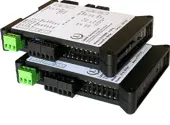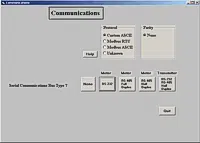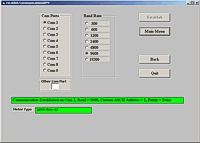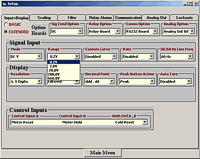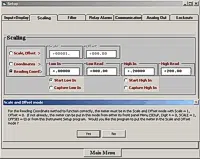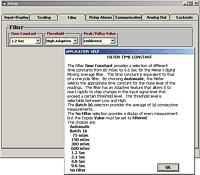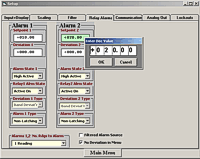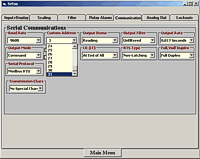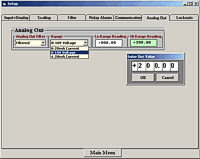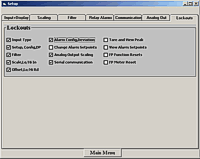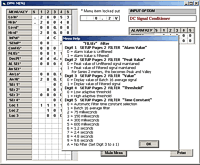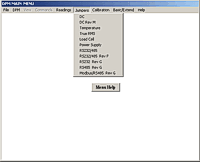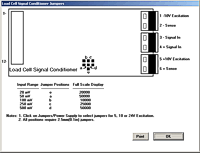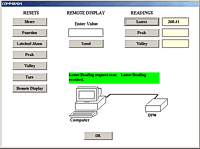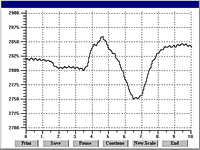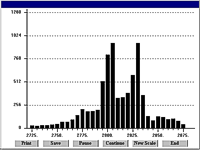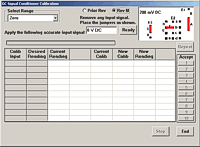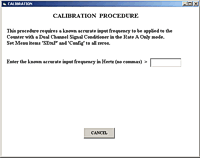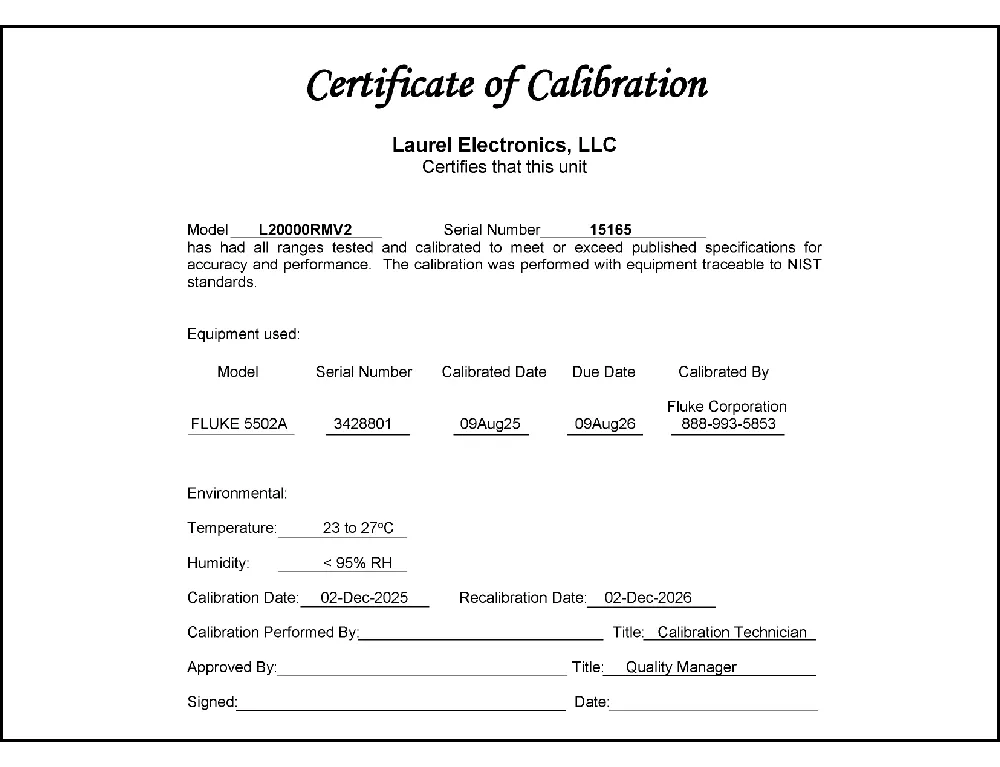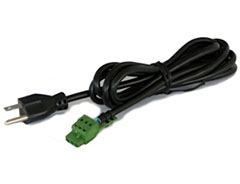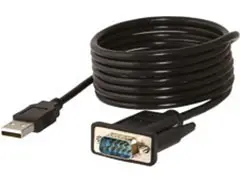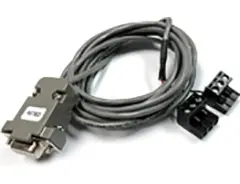Features
- 200 mV, 2V, 20V, 200V, 300V & 600V DC voltage input ranges
- 2, 20, 200 mA and 5A DC current input ranges
- Accuracy ±0.01% of reading ± 2 counts
- Absolute and ratiometric mode for bridges and potentiometers
- Error less than 0.01% of full scale for absolute ranges, less than 0.01% of reading for ratiometric measurements
- All input ranges are user selectable and factory calibrated
- Up to 60 conversions per second, Ideal for peak or valley capture
- Digital span adjust from 0 to ±99,999, zero adjust from -99,999 to +99,999
- 4-20 mA, 0-20 mA, 0-10V or -10V to +10V transmitter output, (isolated)
- Analog output resolution 0.0015% of span, accuracy ±0.02% of span
- RS232 or RS485 serial data, Modbus or Laurel ASCII protocol (isolated)
- Dual 120 mA solid state relays for alarm or control (isolated)
- 5V, 10V, 12V, or 24V dc transducer excitation output (isolated)
- Power 85-264 Vac / 90-300 Vdc or 10-48 Vdc / 12-32 Vac (isolated)
- DIN rail mount housing, 22.5 mm wide, detachable screw-clamp connectors
- Operating temperature from -40°C to 70°C (-40°F to 158°F)
Optional - Extended allows up to 180 data points for custom curve linearization and a rate derived from consecutive readings.
Certificates of Compliance
The Laureate™ LT Series DIN rail analog transmitter with serial data communication and analog outputs for versatile connectivity.
The digitally programmable transmitter features two relays for alarm or control. The series offers exceptional accuracy of 0.01% of reading ± 2 counts, with high read rates at up to 60 or 50 conversions per second. The LT Series transmitters offer the same high performance, signal conditioning, and programmable features as Laureate digital panel meters, counters, and timers.The Laureate 4-20 mA, 0-20 mA, 0-10V or -10V to +10V and RS232/RS485 output transmitter for process signal input provides zero and span adjustment for use with a wide range of industrial transducers. Six DC voltage and four DC current input ranges are jumper selectable. The two most sensitive voltage ranges, 200.00 mV and 2.0000V, provide a high input impedance of 1 GΩ to minimize the load on the voltage signal.
The transmitter can be set to a ratio (or potentiometer follower) mode by making selections at the connector and in software. In this mode, the transmitter output tracks a ratio of the applied excitation voltage and is unaffected by changes in the excitation voltage. Ratiometric measurements provide an exceptional accuracy of 0.01% of reading ± 2 counts. This capability is used with the transmitter's 5V or 10V excitation output for load cells and Wheatstone bridges, and with the transmitter's 5V excitation output for potentiometers which track wiper position.
All signal conditioner board ranges are factory-calibrated, with calibration factors for each range securely stored in an onboard EEPROM. These factors can be scaled via software to accommodate external shunts, enabling field replacement of signal conditioner boards without necessitating recalibration of the associated transmitter. For optimal accuracy, factory recalibration is recommended annually. All Laurel Electronics instruments undergo factory calibration using the industry-leading Fluke calibrators, which are recalibrated yearly and certified traceable to national standards, ensuring the highest level of precision and reliability.
The optional extended Laureate computer board enhances Laureate transmitter by displaying rates derived from successive readings and enabling highly accurate custom curve linearization. For example, it can calculate liquid volume or flow rate in a horizontal cylindrical tank using levels from a 4-20 mA transmitter. Setup is straightforward: users input up to 180 data points into a spreadsheet or text file, and the computer calculates spline-fit segments, which are then downloaded to the transmitter for precise operation.
Laureate Transmitters are easily programmed with Laurel’s free Instrument Setup Software, downloadable from our website and compatible with Windows PCs, requiring a data interface board for setup.
High read rate of up to 50 or 60 conversions per second, the Laureate™ LT Series transmitter uses Concurrent Slope (US Pat. 5,262,780) analog-to-digital conversion to integrate signals over a full power line cycle (50 Hz or 60 Hz). This read rate enables peak and valley capture, real-time computer interfacing, and control applications. Peak and valley values are automatically captured and can be viewed using Laurel’s free Instrument Setup Software (compatible with Windows PCs) or transmitted as serial data.
Standard Hardware Features of Laureate LT Transmitters Include:
- Serial communications output, (isolated), RS232 or RS485 (half or full duplex), jumper selectable. Three protocols are user selectable: Modbus RTU, Modbus ASCII, or Laurel ASCII. Modbus operation is fully compliant with Modbus Over Serial Line Specification V1.0 (2002). The Laurel ASCII protocol is simpler than the Modbus protocol and is recommended when all devices are Laureates.
- 4-20 mA, 0-10V or -10V to +10V analog transmitter output, (isolated), jumper-selectable and user scalable. All selections provide 0.0015% resolution of output span and 0.02% output accuracy of a reading from -99,999 to +99,999 counts that is also transmitted digitally. Output isolation from signal and power grounds eliminates potential ground loop problems. Note that Ethernet data I/O is provided by Laurel's LTE series transmitters.
- Dual solid state relays, (isolated), for alarm or control. Rated 120 mA at 130 Vac or 180 Vdc.
- Selectable transducer excitation output, (isolated), user selectable 5V@100 mA, 10V@120 mA, 12V@100mA, or 24V@50 mA.
- Power 85-264 Vac, (isolated), low-voltage 10-48 Vdc or 12-32 Vac power is optional.
Digital signal filtering modes can be selected to ensure stable readings in electrically noisy environments.
- An unfiltered selection provides true peak and valley readings and aids in control applications.
- A batch average filter selection averages each 16 conversions.
- An adaptive moving average filter selection provides a choice of 8 time constants from 80 ms to 9.6 seconds. When a significant change in signal level occurs, the filter adapts by briefly switching to the shortest time to follow the change, then reverts back to its selected time constant. An Auto setting selects the time constant selection based on signal noise.
Two tare functions: auto-tare and manual tare. In auto-tare, an input line is grounded by an external pushbutton. This causes the current weight, which is normally the empty weight of the container to be stored in memory as an offset. In manual tare, the tare value can be entered manually via a control input pushbutton or using Laurel's free Instrument Setup Software.
Peak and valley values are automatically captured. These may be displayed via Laurel's free Instrument Setup Software, which runs on a PC under MS Windows or can be transmitted as serial data.
Two control inputs (CMOS/TTL levels, logic 0 = tied to digital ground, logic 1 = open) or dry contacts that can be set to control / activate 14 transmitter commands.
An (isolated) 5, 10, 12, or 24 Vdc excitation output is standard to power transducers or two-wire transmitters. Ratiometric operation, which automatically compensates for changes in the applied excitation, is jumper selectable for applications, such as bridges, where the signal to be measured is proportional to the excitation level.
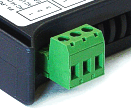
LT series DIN rail Transmitters & signal conditioners can be interfaced to a wide range of sensors and transducers using one of seven available plug-in signal conditioner boards. The transmitters duplicate the high performance (high accuracy and high read rate) and extensive programmable features of Laureate 1/8 DIN digital panel meters, counters, and timers. They utilize the same signal conditioners boards, much of the same firmware, and Laurel's free Windows-based Instrument Setup Software. They come in a compact DIN rail mount package with detachable screw-clamp connectors for easy wiring.
The LT series Transmitters feature isolated, user-selectable analog outputs (4-20 mA, 0-20 mA, 0-10V, or -10V to +10V), an RS232 or RS485 serial data interface, and dual 120 mA solid state AC/DC relays. Most models, except those with temperature or AC RMS signal conditioners, include an isolated 5, 10, 12, or 24 Vdc transducer excitation output.
Connecting Laureate LT Transmitters to a Local Area Network (LAN)
Up to 30 Laureate LT Transmitters and/or Digital Panel Meters can be configured for RS485 and daisy-chained to an LT Transmitter for seamless LAN integration. Alternatively, Laurel LTE series Ethernet transmitters can connect directly to a LAN via an Ethernet cable. Setup for both configurations is streamlined using Laurel’s free Instrument Setup Software, which simplifies node discovery and transmitter configuration.
Flexible Communication Options for LT Transmitters
Laureate Transmitters can be equipped with Laurel communication boards to support various interfaces and protocols. These include serial interfaces with ASCII or Modbus RTU protocols, and Ethernet interfaces with web access, ASCII, or Modbus TCP/IP protocols, ensuring versatile connectivity for your commercial applications.
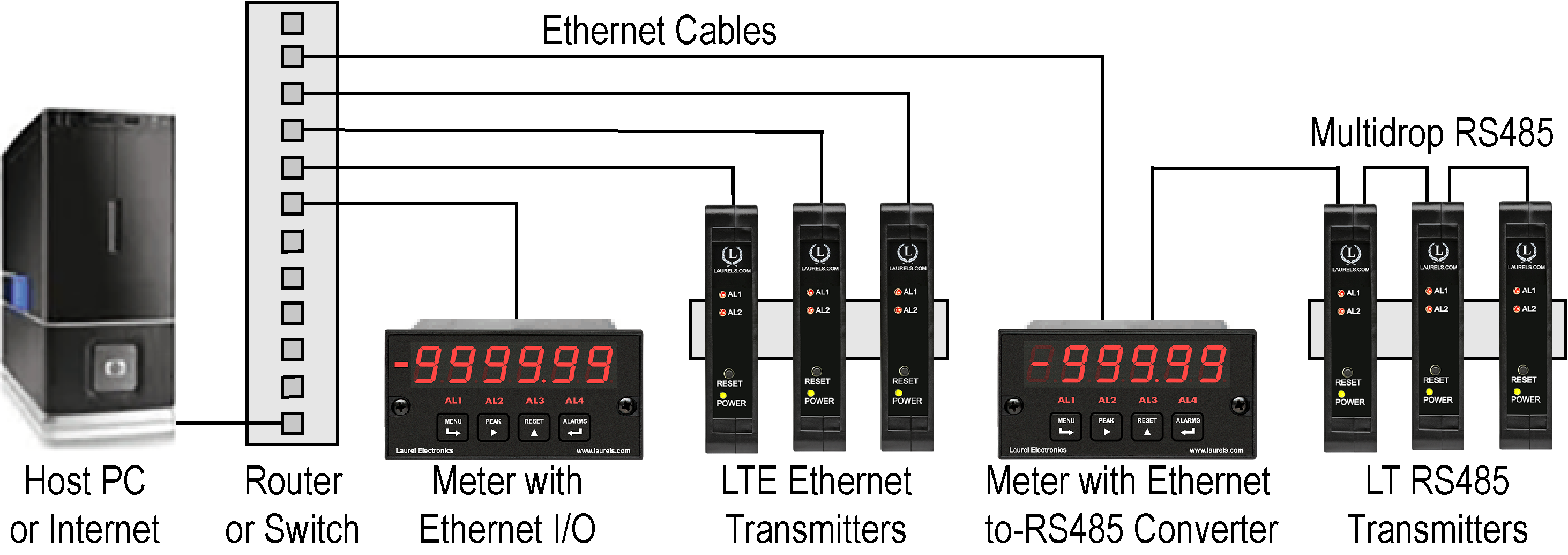
| LT Transmitter Signal Input & Function | Model Series | Analog Output | RS232 & RS485 | Dual Relays | |
|---|---|---|---|---|---|
| 1 | DC Input Voltage and Current | LT-DC |  |
 |
 |
| 2 | AC RMS Voltage or Current | LT-RMS |  |
 |
 |
| 3 | Process Voltage or Current | LT-P |  |
 |
 |
| 4 | Weighing Applications | LT-WA |  |
 |
 |
| 5 | Load Cell & Microvolt Signals | LT-WM |  |
 |
 |
| 6 | Thermocouple (Types J, K, T, E, N, R, S) | LT-TC |  |
 |
 |
| 7 | RTD Temperature | LT-RTD |  |
 |
 |
| 8 | Resistance in Ohms | LT-R |  |
 |
 |
| 9 | Frequency, Rate, Speed | LT-FR |  |
 |
 |
| 10 | Pulse Input Totalizer | LT-FR |  |
 |
 |
| 11 | Process Signal Totalizer | LT-VF |  |
 |
 |
| 12 | Sum, Difference, Ratio, Product of 2 Inputs | LT-FR |  |
 |
 |
| 13 | Batch Controller Pulse Input | LT-FR |  |
 |
 |
| 14 | Batch Controller Analog Input | LT-FR |  |
 |
 |
| 15 | On/Off Duty Cycle | LT-FR |  |
 |
 |
| 16 | Stopwatch Timing for Single Events | LT-FR |  |
 |
 |
| 17 | Average Time of Periodic Events | LT-FR |  |
 |
 |
| 18 | AC Phase Angle and Power Factor | LT-FR |  |
 |
 |
| 19 | Quadrature Position or Rate | LT-QD |  |
 |
 |
4-20 mA transmitter for process & ratiometric input signals
| Analog Input | Range | Resolution | Reading Accuracy | Input Ohms |
|---|---|---|---|---|
| DC Voltage | ±200.00 mV | 10 µV | 0.01% FS ± 2 cts | 1 GΩ |
| ±2.0000 V | 100 µV | 0.01% FS ± 2 cts | 1 GΩ | |
| ±20.000 V | 1 mV | 0.01% FS ± 2 cts | 10 MΩ | |
| ±200.00 V | 10 mV | 0.01% FS ± 2 cts | 10 MΩ | |
| ±600.0 V* | 100 mV | ± 0.4 V | 10 MΩ | |
| DC Current | ±2.0000 mA | 0.1 µA | 0.01% FS ± 2 cts | 100 Ω |
| ±20.000 mA | 1 µA | 0.01% FS ± 2 cts | 10 Ω | |
| ±200.00 mA | 10 µA | 0.01% FS ± 2 cts | 1 Ω | |
| ±5.000 A | 1 mA | ±10 mA | 0.01 Ω | |
| * Range not ETL certified. | ||||
| Reading Accuracy | 0.01% of full scale ± 2 counts (except 5A range) for absolute measurements. 0.01% of reading ± 2 counts for ratiometric measurements. |
|||
| Update Rate, Max | 50/sec at 50 Hz, 60/sec at 60 Hz | |||
| Max applied voltage | 600 Vac for 20, 200 & 600 V ranges, 125 Vac other ranges | |||
| Over-current protection | 25x for 2 mA, 8x for 20 mA, 2.5x for 200 mA, 1x for 5 A | |||
| Recalibration: All ranges are calibrated at the factory. Recalibration is recommended every 12 months. | ||||
| Analog Output (standard) | ||||
| Output Levels | 4-20 mA, 0-20 mA, 0-10 Vdc, -10 to +10Vdc (user selectable) | |||
| Compliance, 4-20 mA | 10V (0-500Ω load) | |||
| Compliance, 0-10V | 2 mA (5 kΩ load) | |||
| Output Resolution | 16 bits (65,536 steps) | |||
| Output Accuracy | 0.02% of output span plus conversion accuracy | |||
| Output Isolation | 250V rms working, 2.3 kV rms per 1 minute test | |||
| Serial Data Output (standard) | ||||
| Signal Types | RS232 or RS485 (half or full duplex), jumper selectable | |||
| Data Rates | 300, 600, 1200, 2400, 4800, 9600, 19200 baud | |||
| Output Isolation | 250V rms working, 2.3 kV rms per 1 min test | |||
| Serial Protocols | Modbus TCP, Modbus RTU, Modbus ASCII, Custom ASCII | |||
| Modbus Compliance | Modbus over Serial Line Specification V1.0 (2002) | |||
| RS232/RS485 | Screw terminal connector for easy daisy chaining | |||
| Digital Addresses | 247 for Modbus, 31 for Custom ASCII | |||
| Dual Relay Output (standard) | ||||
| Relay Type | Two solid state relays, SPST, normally open, Form A | |||
| Load Rating | 120 mA at 140 Vac or 180 Vdc | |||
| Excitation Output (standard) | ||||
| 5 Vdc | 5 Vdc ± 5%, 100 mA (jumper selectable) | |||
| 10 Vdc | 10 Vdc ± 5%, 120 mA (jumper selectable) | |||
| 12 Vdc | 12 Vdc ± 5%, 100 mA (jumper selectable) | |||
| 24 Vdc | 24 Vdc ± 5%, 50 mA (jumper selectable) | |||
| Output Isolation | 50 Vdc from signal ground | |||
| Ratiometric operation | 5 Vdc or 10 Vdc for bridge circuits, 5 Vdc for potentiometers | |||
| Power Input | ||||
| Standard Power | 85-264 Vac or 90-300 Vdc | |||
| Low Power Option | 10-48 Vdc or 12-32 Vac | |||
| Power Frequency | DC or 47-63 Hz | |||
| Power Isolation | 250V rms working, 2.3 kV rms per 1 min test | |||
| Power Consumption at 24V | 1.5W typical, 3W with max excitation output | |||
| Signal Connections | ||||
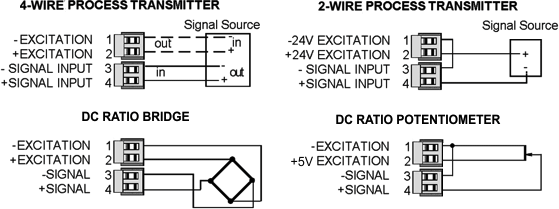 |
||||
| Environmental | ||||
| Operating Temperature | -40°C to 70°C (-40°F to 158°F) | |||
| Storage Temperature | -40°C to 85°C (-40°F to 185°F) | |||
| Relative Humidity | 95% at 40°C, non-condensing | |||
| Cooling Required | Mount transmitters with ventilation holes at top and bottom. Leave 6 mm (1/4") between transmitters, or force air with a fan. | |||
| Mechanical | ||||
| Enclosure | Rugged black polycarbonate housing material | |||
| Mounting | 35 mm rail per DIN EN 50022 | |||
| Dimensions | 129 x 104 x 22.5 mm case | |||
| Connectors | Detachable screw clamp connectors meet VDE / IEC / UL / CSA standards. RJ45 jack for Ethernet | |||
| Tightening Torque | Screw terminal connectors: 5 lb-in (0.56 Nm) | |||
| Weight | Complete transmitter: 183 g (6.5 oz) | |||
| Replacement Case Screws | ||||
| Size | 6 | |||
| Thread Pitch | 6-19 | |||
| Length | 1/2" | |||
| Head Style | Pan Head | |||
| Drive Style | Phillips | |||
| Head Diameter | 0.256-0.270 | |||
| Head Height | 0.087-0.097 | |||
| Full/Partial Thread | Full | |||
| Drive Size | 2 | |||
| Material | Steel | |||
| Finished | Black Oxide | |||
| General | ||||
| Programming | Utilize Laurel's free Instrument Setup Software, which runs on a PC under MS Windows. | |||
| Security | Lockout options available using Laurel's free Instrument Setup Software. | |||
| Warranty | 3 years parts & labor | Recalibration: All ranges are calibrated at the factory. Recalibration is recommended every 12 months. | ||
Transmitter Pinout
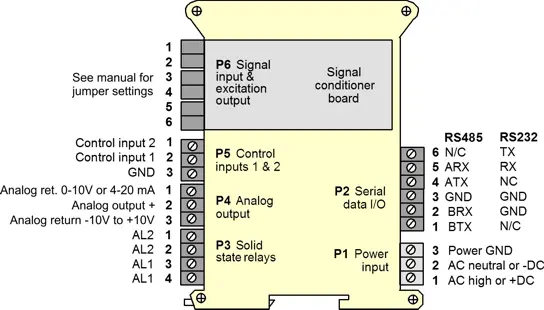
Custom curve linearization
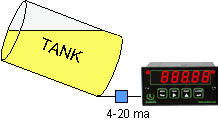
A Laureate process meter or transmitter with the Extended main board option allows exceptionally accurate custom curve linearization. For setup, up to 180 data points can be entered into a spreadsheet. The system then creates multiple non-linear spline-fit segments, which provide much better accuracy than linear segments. One application, as illustrated, is the readout of volume of irregularly shaped tanks based on measured liquid level or pressure. Altimeters and thermistors are further applications.
Free Instrument Setup Software for Series 2 Laureates
Free Downloadable Windows-based Instrument Setup (IS) software (Data Interface Board Required) for use with our programmable Digital Panel Meters, Scale Meters, Counters, Timers, Remote Displays, and Transmitters, are an easy method to set up Laureate 1/8 DIN digital panel meters, counters, timers, remote displays, and DIN-rail transmitters, as explained in the Instrument Setup Software Manual. Laureate 1/8 DIN instruments can also be set up from the front panel, as explained in their respective Owners Manuals. Instrument Setup software is of benefit whether or not the PC is connected to the instrument.
- When the PC is connected to the instrument, Instrument Setup software can retrieve the setup file from the instrument or open a default setup file or previously saved setup file from disk View Setup, then provides graphical user interface (GUI) screens with pull-down menus applicable to input, display, scaling, filtering, alarms, communications, analog output, and front panel lockouts. Fields that are not applicable to the instrument as configured are either left out or grayed out. Clicking on any item will bring up a detailed Help screen for that item. After editing, the setup file can be downloaded, uploaded to the instrument, or saved to a disk. The same setup file can then be downloaded into multiple instruments.
- When the PC is not connected to the instrument, the above GUI screens can be used to set up a virtual instrument. The setup file can then be saved to disk. Switching toView Menu then brings up a screen with the required front panel programming steps. This view can be printed out for use at the instrument site and to serve as a hard copy record.
Download Free Instrument Setup Software
Installation
Set User Account Control (UAC) of MS Windows to "Never notifiy me" so that Instrument Setup Software can create directories. The UAC change screen can be reached as follows:
- Under Windows 7, click on the Windows Start button in the lower left of the desktop and enter "UAC" in the search field.
- Under Windows 8, navigate to Control Panel, then to the "User Accounts and Family Safety" section, and click on "Change User Account Control Settings."
- Under Windows 10, click on the Windows Start button in the lower left of the desktop, then on "Settings", and enter "UAC" in the search field.
- Reboot your computer for the changed UAC setting to take effect.

RJ11-to-DB9 cable with rear view of DB9 connector to PC
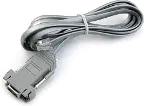
RS232 cable, meter to PC, P/N CBL01
Laureate 1/8 DIN Laureate instruments must be equipped with a serial communications board and be connected to the computer via a serial communications cable. The connection can be via RS232, RS485, USB or Ethernet. Following setup, the serial communications board may be removed from the instrument if desired. The wiring of the RS232 cable is illustrated above with end views of the two connectors.
Laureate LT Series transmitters come standard with a 3-wire serial interface, which can be jumpered for RS232 or RS485.
Laureate LTE Series transmitters come standard with an Ethernet interface.
Meter Setup Screens
Click on any of the reduced screens below for a full-size screen view, then click on the Back button of your browser to return to this page. The screens examples below are for a fully-loaded Series 2 Digital Panel Meter (DPM), which is connected to the PC via RS232. If the meter is a Series 1 meter (pre-2007), this is sensed by the software, and somewhat different screens are brought up. Please see Series 1 setup screens.











Meter Setup Utilities




From the Main Menu, click on Readings if your PC is connected to the meter. A pull-down menu then offers three choices: List, Plot and Graph.
- List presents the latest readings in a 20-row by 10-column table. Press Pause at any time to freeze the display. This is one method to capture peak readings.
- Plot generates a plot of readings vs. time in seconds. It effectively turns the DPM-PC combination into a printing digital oscilloscope.

- Graph generates a histogram where the horizontal axis is the reading and the vertical axis is the number of occurrences of readings. The display continually resizes itself as the number of readings increases.



Dimensions
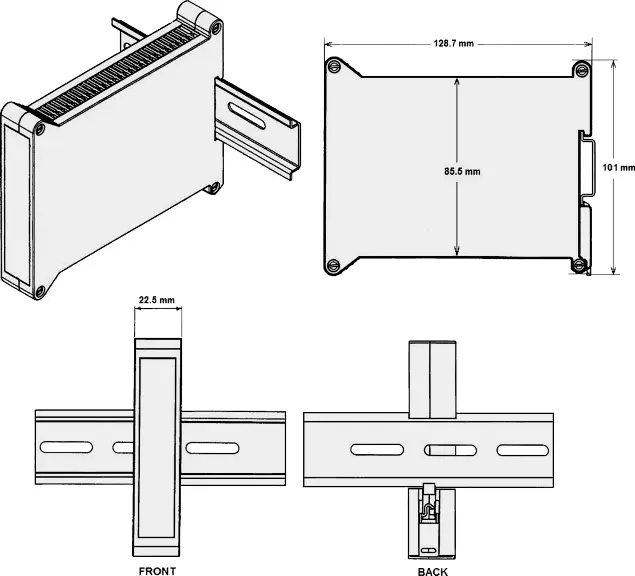
Dimensioned CAD assembly drawings in EPRT, STEP, x_t, .dwg, pdf file formats: Laureate-transmitter-case.zip (zipping prevents browser from opening CAD files as text files).
CAL-Analog
Certificate of Calibration
$65.00CBL02
USB-to-RS232 Adapter Cable
$47.00CBL04
RS232 Cable for LT Transmitters
$47.00Exploring the LT DIN Rail Analog Transmitter with Serial Data Communication and Analog Outputs for Process and Ratiometric Signals
In the realm of industrial automation and process management, accurate measurement and dependable data transfer are essential. A critical device that fulfills these requirements is the LT DIN Rail Analog Transmitter, which integrates multiple key functions such as serial data communication and analog outputs, offering significant flexibility for managing process and ratiometric signals. This article examines the factors that make this transmitter an indispensable asset in today’s industrial landscapes.
What is an LT DIN Rail Analog Transmitter?
The LT DIN Rail Analog Transmitter is an electronic unit crafted to transform various input signals into standardized analog outputs. It is generally mounted on a DIN rail, a universally accepted metal rail designed for securing circuit breakers and industrial control devices. The "LT" designation typically highlights a specific model or series, reflecting unique characteristics or specifications.
Key Features and Benefits
-
DIN Rail Mounting: This design allows the transmitter to be attached to a DIN rail, streamlining installation and ensuring smooth compatibility with other rail-mounted equipment, while also promoting an orderly control panel arrangement.
-
Analog Outputs: The LT transmitter delivers analog output signals that serve as a bridge to other control systems or instrumentation, playing a vital role in relaying data to monitoring tools, controllers, or data collection systems.
-
Serial Data Communication: In addition to analog outputs, the transmitter supports digital data transmission, providing benefits like enhanced accuracy, minimized signal interference, and the potential to connect with digital communication networks.
-
Process and Ratiometric Signals: Capable of processing signals related to process variables (e.g., temperature, pressure, level) and ratiometric signals (e.g., those proportional to a reference voltage), this transmitter adapts to a broad spectrum of industrial needs.
How It Works
The LT DIN Rail Analog Transmitter functions by accepting an input signal from a sensor or measurement device, which might represent a physical parameter like temperature or pressure through voltage, current, or resistance values. The transmitter then processes this input and converts it into a standardized analog output, such as 4-20 mA or 0-10 V, suitable for use by other equipment.
Furthermore, it can transmit data digitally using serial protocols like RS-232 or RS-485, enabling advanced data handling and integration with digital systems, which supports features such as remote oversight and data recording.
Applications
The LT DIN Rail Analog Transmitter finds application across various industrial contexts, including:
-
Process Control: In sectors like manufacturing, chemical processing, and oil and gas, it ensures accurate monitoring and regulation of process variables to maintain peak performance.
-
Building Automation: Within HVAC systems and building management setups, the transmitter assists in tracking environmental conditions and managing control systems based on process and ratiometric inputs.
-
Automotive Industry: It supports the monitoring and adjustment of parameters in automotive production, ensuring precise data management and system integration.
Conclusion
The LT DIN Rail Analog Transmitter, equipped with serial data communication and analog outputs, is a versatile and vital instrument in industrial automation and process control. Its capacity to manage both analog and digital signals, coupled with its straightforward DIN rail installation, positions it as a key resource for precise measurement and reliable data transmission. Whether applied in process control, building automation, or automotive manufacturing, this transmitter delivers the accuracy and functionality required for effective system operation.
Exploring the Applications of LT DIN Rail Analog Transmitters with Serial Data Communication and Analog Outputs
Introduction
Within the sphere of industrial automation and process oversight, LT DIN rail analog transmitters with serial data communication and analog outputs are pivotal. These devices are essential for transforming diverse process and ratiometric signals into standardized outputs that support easy monitoring and regulation. This article investigates the practical uses and benefits of these adaptable transmitters, showcasing their role across different industrial environments.
What is an LT DIN Rail Analog Transmitter?
An LT DIN rail analog transmitter is an instrument developed to convert signals from sensors or measuring tools into analog or digital outputs. It is typically installed on a DIN rail, a standard mounting solution in industrial settings that offers a secure and convenient way to position the transmitter with other control devices. The "LT" label often denotes a particular model or manufacturer, with "analog transmitter" describing its core function.
Key Features
-
Serial Data Communication: This function enables the transmitter to interact with other devices or systems through serial protocols like RS-232 or RS-485, which is vital for integrating into extensive control networks and supporting remote data collection.
-
Analog Outputs: The transmitter generates output signals in analog forms, such as 4-20 mA or 0-10 V, which represent measured process or ratiometric signals in a format easily understood by control systems, displays, or monitoring tools.
-
Process and Ratiometric Signals: This device can manage a range of input signals, including those from pressure, temperature, level, and flow sensors, as well as ratiometric signals prevalent in applications requiring high precision.
Applications
-
Industrial Process Control: In manufacturing and processing sectors, these transmitters monitor and regulate process variables like temperature, pressure, and flow rates, converting sensor data into outputs that support PLCs or other control systems to sustain ideal conditions.
-
Building Automation: They are utilized in building automation to manage environmental factors, such as monitoring HVAC systems and converting sensor data into control signals for heating, ventilation, and air conditioning.
-
Energy Management: For energy management tasks, these transmitters track and optimize energy use by interfacing with energy meters and delivering real-time data on electrical parameters to enhance efficiency.
-
Laboratory and Research: In lab environments, where precise monitoring is necessary, these transmitters collect data from experimental setups, transforming raw sensor readings into useful outputs for analysis and documentation.
-
Automotive Industry: In automotive testing and production, they monitor and adjust parameters like engine performance and fuel efficiency, providing dependable data for quality assurance and diagnostics.
Advantages
- Versatility: The capacity to process both process and ratiometric signals suits these transmitters for a wide variety of uses.
- Integration: Serial data communication simplifies integration into existing networks, supporting remote oversight and control.
- Accuracy: Analog outputs guarantee precise and reliable data transmission, essential for maintaining process stability and quality.
Conclusion
LT DIN rail analog transmitters with serial data communication and analog outputs are indispensable in contemporary industrial and research settings. Their ability to convert a range of input signals into standardized outputs enhances efficient monitoring and control across multiple applications. By recognizing their capabilities and applications, professionals can maximize the potential of these devices to improve system performance, ensure precision, and achieve operational success.
Less Information.








